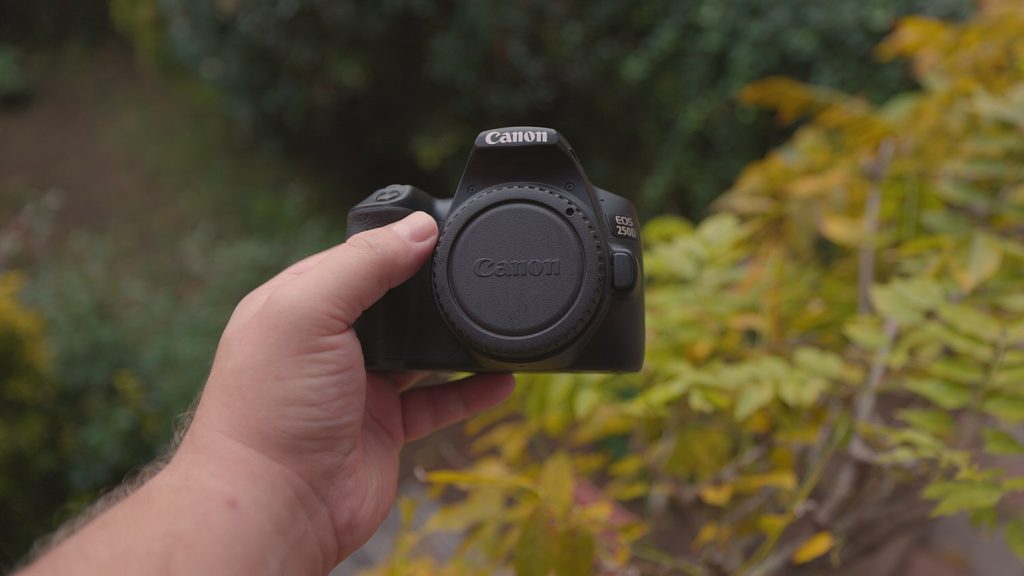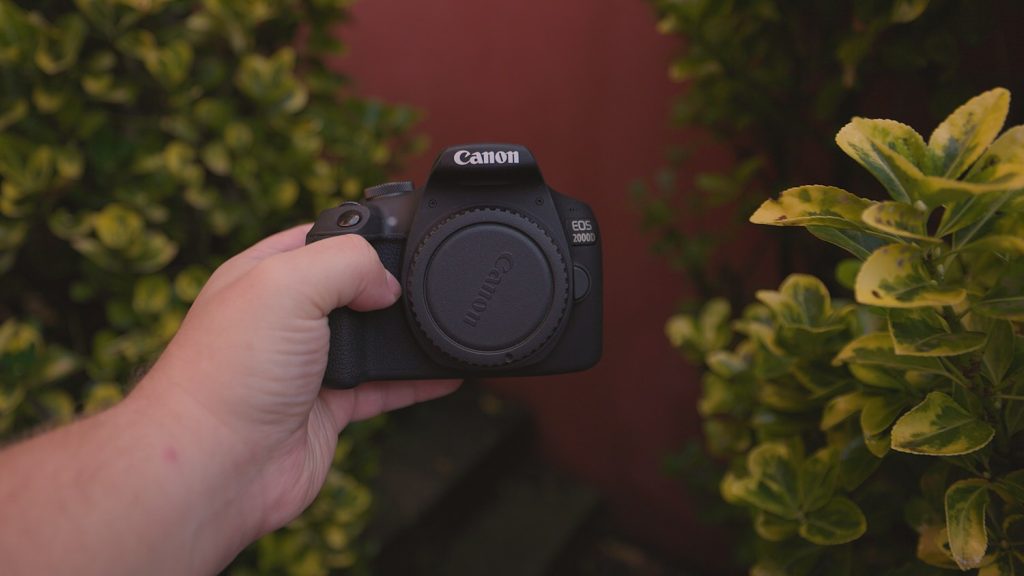Perhaps you are considering purchasing the Canon 250D, also known as the Canon SL3或 佳能 Rebel T7, also known as the 2000D, but you’re not sure if they’re still good in 2023. In this review, we’ll discuss whether these cameras are still a good choice and whether you should buy either of them.

兼容镜头
To begin with, which lenses can I use with these cameras? Both Canon EF and EF-S lenses will work with both cameras discussed here, including the Canon EF 50mm f/1.8 and the Canon EF-S 18-55mm kit lens. You can also opt for third-party lenses to have a vast assortment of options.
I’ve actually reviewed quite a few lenses on my YouTube channel. Feel free to have a look at my 我 YouTube 频道上的播放列表.
存储
Next up, what about storage? Can they use two SD cards? No, entry-level or mid-level cameras do not have this feature. This feature is considered high-end because it allows for real-time backups of your photos, as each photo is saved on both cards.
It is particularly useful for pro gigs, as it can help you recover everything from the second SD card, even if the first one fails. Although SD card failures are rare, having multiple SD cards you cycle through over time can prevent data loss.
Furthermore, you have the option to disregard the backup function and utilise each card individually, which results in a doubling of your storage space.

连接性
Building on that idea, how are they in terms of connectivity? Both cameras have the capability to use Wi-Fi. However, the 250D has no Bluetooth feature, whereas the T7 has it. Also, the T7 has NFC capabilities, which the 250D does not have.
尺寸和结构
Okay, so is their size an issue? The 250D has dimensions of 122.4 x 92.6 x 69.8mm, or 4.82 x 3.65 x 2.75″. It weighs approximately 450 grams, which is 15.87 ounces. On the other hand, the T7 has dimensions of 129 x 101.3 x 77.6mm or 5.08 x 3.99 x 3.06″. Its weight is about 475 grams, which is 16.76 ounces.
These measurements show they have a similar physical size, making them portable and unobtrusive. However, their size could be affected by the lenses chosen for them.
When it comes to construction, the 250D boasts a superior build quality when compared to the T7. The 250D is comprised of aluminium alloy and polycarbonate resin with glass fibre, whereas the T7 由聚碳酸酯树脂、玻璃纤维和特殊导电纤维制成。
显示屏
Moving on to a related point, what about their screens? They’re enough so that you can navigate through menus and view photos. The 250D camera has an articulated screen perfect for vlogging, while the T7 has a fixed screen.
Not only that but the screen on the 250D can be turned around to protect it from scratches when it’s carried in a bag.

电池寿命
So, both of these cameras can do quite a bit. How long will their battery last me? The LP-E17 battery of the 250D can capture about 1,000 shots, while the LP-E10 battery of the T7 lasts for approximately 500 photos.
Several aspects can affect battery life, including the frequency of screen usage, the age of the batteries, and the air temperature. It is a wise practice to carry extra batteries with you, particularly if there are other people involved in the shoot, in case you run out of juice.
图像质量
Okay, so can they produce quality photographs? The images you capture greatly depend on which lens you choose, but let’s focus solely on the camera’s contribution.
传感器
To begin, let’s talk about the sensors. The 250D and T7 cameras share a similarly-sized APS-C sensor, measuring 22.3 x 14.9mm and offering a resolution of 24.1 MP for both cameras.
处理器
The DIGIC 8 processor is present in the 250D, while the DIGIC 4+ is present in the T7. You may be wondering what the difference is. Let’s take a look at the improvements the DIGIC 8 and 4+ have brought to Canon cameras.
With the 4th DIGIC generation, faster image processing was introduced, an upgrade from the previous models. Not only that, but there was also better noise reduction implemented in high-ISO images, and additionally, H.264 1080p video recording technology was included.
The 8th iteration of DIGIC processors brought about many improvements, such as 4K video recording at 30 frames per second, better Dual Pixel autofocus, enhanced autofocus, and improved tracking performance.
国际标准化组织
Regarding ISO, the 250D has a range of 100 to 25,600. When expanded, it can go up to 51,200 ISO. Similarly, the T7 can range from 100 to 6400, which can be expanded to 12,800 ISO. Remember, it is advisable to maintain a lower ISO to avoid unnecessary noise in images.
自动对焦
Regarding autofocus, the 250D and T7 provide up to 9 AF points. Moving on to a related point, is either of them equipped with Dual Pixel AF? So, the 250D does have it, while the T7 does not. The presence of Dual Pixel AF and a high number of AF points usually means significantly better autofocusing capability, which can be incredibly helpful, especially when something’s happening and you need to take a photo fast.
快门速度
Another important point to consider is, what is their maximum shutter speed? If you want to capture fast-moving subjects, can these cameras do that? Both of these cameras have a maximum shutter speed of 1/4000th of a second, which is nice.
Sports, or Wildlife
Next up, what if you want to do sports or wildlife photography, and thus you need to take loads of photos in quick succession? If so, what you’re looking for is continuous shooting mode.
The 250D can do 5 fps in this mode, while the T7 can do 3 fps. In other words, within one second, the 250D captures 5 photos, while the T7 captures 3. This is very useful if you’re trying to capture fast-moving subjects. Within that second, the more frames your camera is able to freeze, the better the possibility you will obtain the exact image you desire.
视频
Right, so can you use them for video? The 250D can record 4K at 24fps and 1080p at 60fps, while the T7 can record 1080p at 30fps and 720p at 60fps. However, neither of these cameras has Canon Log, which is a feature typically found in more expensive cameras that lets you capture more dynamic range.
There is a caveat to the 4K on the 250D, though, which is that it applies a 1.7x crop to the sensor, making the image really zoomed in.
Another important point to consider is whether these cameras stabilise footage. Nope, neither of these cameras has IBIS. Now, most cameras offer digital stabilisation, but as a general rule, you should stay away from that.
IBIS
While the in-body digital image stabilisation (IS) can be adjusted, it’s usually ineffective. Additionally, the IS is incorporated into the video, meaning you can’t remove it if you don’t like it. Is it worth it to use the in-body digital IS? Not really.
It’s better to shoot shaky footage and then stabilise it using editing software such as Premiere. This is even more crucial because the quality of stabilisation software is constantly improving. If you are interested in optical stabilisation, you can opt for a lens such as the 佳能 EF-S 18-55mm 套装镜头, which has IS in the name. Choosing this will provide you with in-lens stabilisation that is superior to in-camera digital stabilisation.

视频博客
Now, can you vlog with these cameras? At this point, pretty much any camera can be used for vlogging, but there are a few issues to bear in mind. First off, having a flip screen is ideal, so you can see what you’re doing when the camera is turned around.
Regarding flip screens, the 250D has one, while the T7 does not. A flip screen makes vlogging much easier and protects the screen while in your bag. Something else to consider is the sensor type. Both cameras have APS-C sensors, which means the image is more zoomed-in than Full Frame sensors.
Due to this, it’s best to use lenses with shorter focal lengths to offset the camera’s crop factor, ensuring that the lens won’t be too zoomed-in for vlogging. For handheld vlogging, you can use the 18-55mm kit lens, which captures more in frame when zoomed out.
Opt for the version with IS for smoother video recording in almost any scenario. Alternatively, you may use the 佳能 24 毫米薄饼镜头 for wide-angle shots, but remember that it lacks IS, which may result in shakier footage.
优酷用户
If you ever plan on using a tripod, the type of lens you should use will vary. What lens should you avoid in this scenario? Which lenses would be better suited in comparison? If you’re using a tripod, I suggest skipping the 18-55mm and 24mm lenses.
Instead, you may consider using the 佳能 EF 50mm f1.4 或 f1.8 lens. These lenses have the ability to open up significantly wider, allowing more light to enter your camera. Plus, they can create stunning Bokeh, which is that pleasant, blurry background that is so visually appealing.
It’s important to note that these lenses are not ideal for vlogging on the go since they are too zoomed-in and lack IS. I’ve actually reviewed all of these lenses on 我的 YouTube 频道.
长寿
Moving on to a related point, how long should I expect them to last? Neither of them has weather sealing, so you have to be careful about that. I wouldn’t use them in the rain or expose them to the elements in that way.
Both are rated for approximately 100,000 actuations since cameras are mechanical in nature and have a specific lifespan. Each time you snap a photo that counts as one actuation. Considering an average of ten photos per day, 100,000 photos would last around 27 years.
However, other parts of the camera may wear out before that. If buying the cameras second-hand, the calculation may need to be modified. Before buying the camera, check the listing to see the number of photos it has already taken.

应用
What are these cameras designed for? Both are quite versatile and can be utilised for various types of photography, including portraits, street photography, product photography, landscapes, weddings, events, and documentary shots. The camera’s lens selection is more important than the camera when it comes to these types of photography.
When it comes to taking sports and wildlife photos, the situation can get complicated. Apart from selecting the appropriate lens, there are other factors that you need to consider. If you’re interested in this genre of photography, then a speedy shutter and a large number of frames per second in the continuous mode are ideal.
As stated above, the 250D has a continuous shooting speed of 5 frames per second, while the T7 can snap 3 frames per second. Moreover, the maximum shutter speed for the 250D is 1/4000th of a second, and the T7 can do the same.
建议
希望本指南对你有所帮助。我在这里所做的就是帮助人们实现他们的梦想,让他们在任何地方都能通过网络谋生,从而实现地域独立。为此,我教人们如何成为 更好的自由职业者我还向他们展示了所需的工具,例如 相机和镜头和 音频设备.另外,如果您喜欢视频评论,请随时查看我的 YouTube 频道.
最后,您可以在下面找到我在本文中提到的所有项目。



